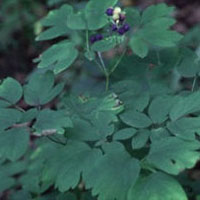Blue Cohosh
Uses
Parts Used & Where Grown
Blue cohosh grows throughout North America. The roots of this flower are used medicinally. Blue cohosh is not related to black cohosh(Cimicifuga racemosa). However, both herbs are primarily used to treat women’s health problems.
Our proprietary “Star-Rating” system was developed to help you easily understand the amount of scientific support behind each supplement in relation to a specific health condition. While there is no way to predict whether a vitamin, mineral, or herb will successfully treat or prevent associated health conditions, our unique ratings tell you how well these supplements are understood by the medical community, and whether studies have found them to be effective for other people.
For over a decade, our team has combed through thousands of research articles published in reputable journals. To help you make educated decisions, and to better understand controversial or confusing supplements, our medical experts have digested the science into these three easy-to-follow ratings. We hope this provides you with a helpful resource to make informed decisions towards your health and well-being.
3 StarsReliable and relatively consistent scientific data showing a substantial health benefit.
2 StarsContradictory, insufficient, or preliminary studies suggesting a health benefit or minimal health benefit.
1 StarFor an herb, supported by traditional use but minimal or no scientific evidence. For a supplement, little scientific support.
This supplement has been used in connection with the following health conditions:
| Used for | Why |
|---|---|
1 Star Amenorrhea Refer to label instructions | Traditional practitioners consider blue cohosh to be a uterine tonic and an agent that stimulates menstrual blood flow, and it is used as a remedy for lack of menstruation. is a traditional remedy for lack of menstruation. It is considered an emmenagogue (agent that stimulates menstrual blood flow) and a uterine tonic. No clinical trials have validated this traditional use. |
1 Star Dysmenorrhea Refer to label instructions | Blue cohosh has been used traditionally for easing painful menstrual periods. Women of childbearing age using this herb should stop using it as soon as they become pregnant. , although unrelated to black cohosh, has also been used traditionally for easing painful menstrual periods. Blue cohosh, which is generally taken as a tincture, should be limited to no more than 1–2 ml taken three times per day. The average single application of the whole herb is 300–1,000 mg. Blue cohosh is generally used in combination with other herbs. Women of childbearing age using this herb should cease using it as soon as they become pregnant—the herb was shown to cause heart problems in an infant born following maternal use of blue cohosh. |
Traditional Use (May Not Be Supported by Scientific Studies)
Native Americans are believed to have used blue cohosh flowers to induce labor and menstruation.1 Blue cohosh is a traditional remedy for lack of menstruation. It is considered an emmenagogue (agent that stimulates menstrual flow) and a uterine tonic. No clinical trials have validated this traditional use. It has also been used traditionally to treat painful periods (dysmenorrhea). Early 20th century physicians in the United States who treated with natural remedies (known as Eclectic physicians) used blue cohosh for these same purposes and also to treat kidney infections, arthritis, and other ailments.
How It Works
A saponin from blue cohosh called caulosaponin is believed to stimulate uterine contractions.2 Several other alkaloids may be active in this herb. However, current research about the active constituents of blue cohosh is insufficient.
How to Use It
Blue cohosh is generally taken as a tincture and should be limited to no more than 1–2 ml taken three times per day. The whole herb (300–1,000 mg per day) is sometimes used. Blue cohosh is generally used in combination with other herbs.
Interactions with Supplements, Foods, & Other Compounds
Interactions with Medicines
Side Effects
Large amounts of blue cohosh can cause nausea, headaches, and high blood pressure. Blue cohosh should only be used under medical supervision and in limited amounts. Using blue cohosh during pregnancy has been brought into question by reports of an infant developing a stroke and another infant being born with congestive heart failure.3, 4 Safety studies need to be completed to determine whether blue cohosh is safe to use during pregnancy.
1. Castleman M. The Healing Herbs. New York: Bantam Books, 1991, 120-3.
2. Foster S. Herbal Renaissance. Salt Lake City: Gibbs-Smith Publisher, 1993, 48-50.
3. Finkel RS, Zarlengo KM. Blue cohosh and perinatal stroke. N Engl J Med 2004 351:302-3.
4. Jones TK, Lawson BM. Profound neonatal congestive heart failure caused by maternal consumption of blue cohosh herbal medication. J Pediatr 1998;132:550-2.
Last Review: 06-08-2015

Copyright © 2024 TraceGains, Inc. All rights reserved.
Learn more about TraceGains, the company.
The information presented by TraceGains is for informational purposes only. It is based on scientific studies (human, animal, or in vitro), clinical experience, or traditional usage as cited in each article. The results reported may not necessarily occur in all individuals. For many of the conditions discussed, treatment with prescription or over the counter medication is also available. Consult your doctor, practitioner, and/or pharmacist for any health problem and before using any supplements or before making any changes in prescribed medications. Information expires December 2024.
This information does not replace the advice of a doctor. Ignite Healthwise, LLC, disclaims any warranty or liability for your use of this information. Your use of this information means that you agree to the Terms of Use. Learn how we develop our content.

